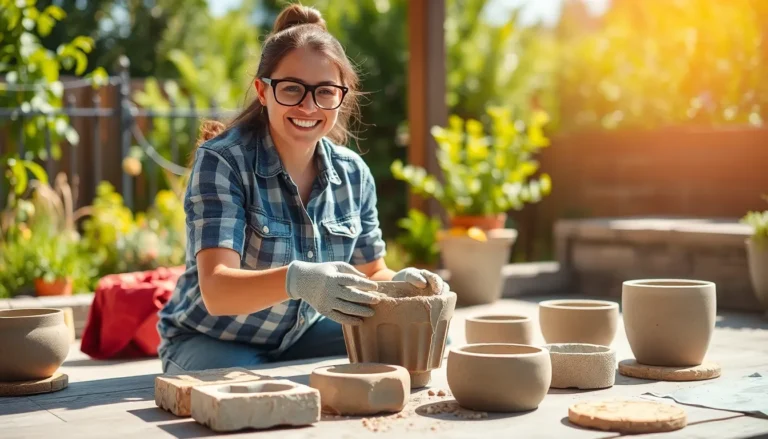Diving into the world of DIY wood projects can feel a bit like stepping into a lumberjack convention—exciting but slightly intimidating. For beginners, the thought of wielding a saw might spark visions of accidental finger painting with blood instead of wood stain. But fear not! With the right guidance and a touch of creativity, anyone can transform simple planks into stunning pieces of art (or at least something that resembles it).
Getting Started with DIY Wood Projects
Beginner woodworkers often feel a mix of excitement and apprehension. With the right tools and knowledge, turning ideas into reality is achievable.
Tools You Will Need
Essential tools create a solid foundation for DIY wood projects. The primary tools include a tape measure for accurate dimensions, a handsaw or power saw for cutting, and a drill for making holes. Safety goggles protect the eyes while working. Sandpaper smooths rough edges for a polished finish. Clamps secure wood pieces together during assembly. A square ensures precise right angles. Having these tools readily available simplifies the project process.
Safety Tips for Beginners
Prioritizing safety remains critical in woodworking. Wearing safety goggles prevents eye injuries from flying debris. Ear protection helps mitigate noise exposure during cutting. Gloves guard against splinters, while sturdy footwear offers foot protection. Maintaining a clean workspace reduces the risk of tripping. Always double-check measurements before making cuts to avoid mistakes. Following these safety precautions promotes a safe and enjoyable woodworking experience.
Simple DIY Wood Projects

Beginners can dive into woodworking with simple, rewarding projects. Each project builds skills and confidence while creating useful items for home.
Wooden Planter Box
Creating a wooden planter box offers an excellent introduction to woodworking. Start by selecting untreated wood, such as cedar or pine, for durability. Measure and cut four pieces for the sides, one for the base, and optionally add drainage holes. Assemble the box using wood screws, ensuring a sturdy structure. Sand the edges to avoid splinters, enhancing safety while handling. Painting or staining the box can personalize its appearance, enhancing its charm in the garden.
Bookshelf for Beginners
A beginner-friendly bookshelf offers a practical project. Choose plywood or pine for a budget-friendly approach. Cut two side panels and two shelves to desired dimensions, maintaining uniformity in measurements. Assemble the structure using wood glue or screws for additional strength. Consider a back panel for stability and added character. Sand all surfaces to promote a smooth finish, ensuring it complements any interior decor. Staining or painting completes the bookshelf, adding a finished look and protecting the wood.
Essential Techniques for Woodworking
Learning essential techniques enhances woodworking skills and overall project success. Beginners benefit significantly from mastering fundamental practices that ensure accuracy and finish quality.
Measuring and Cutting Wood
Accurate measuring is crucial for successful projects. Utilizing a tape measure, beginners should measure twice to confirm dimensions before cutting. A square aids in maintaining straight lines, ensuring clean edges. Tools like a miter saw or circular saw provide precise cutting capabilities. After cutting, checking for square corners ensures a stable assembly. Beginners can practice with scrap wood to refine their measuring and cutting skills, leading to improved confidence in future projects.
Sanding and Finishing Techniques
Sanding prepares wood surfaces for finishing, creating a smooth texture. Starting with coarse-grit sandpaper, move to finer grits for a polished finish. Working with the grain prevents scratches and enhances the wood’s natural beauty. Following sanding, applying a wood finish like stain or sealant protects the surface and enhances aesthetics. Beginners should experiment with different finishes to find their preferred look. Patience is essential during this process, ensuring thorough drying and proper application for the best results.
Creative Ideas for DIY Wood Projects
Exploring creative wood projects can inspire beginners to dive deeper into woodworking. Simple yet engaging ideas enhance skills while adding personal touches to home decor.
Wall Art and Decorations
Creating wall art offers newcomers a chance to express creativity with wood. Choose reclaimed wood or plywood for a rustic aesthetic. Beginners can craft geometric designs or wooden shelves that display plants. Stencils aid in adding patterns or quotes, making each piece unique. Finish your creations with paint or wood stain to enhance appearance and durability. Hang these pieces to brighten walls and showcase personality. This project encourages experimentation with shapes and finishes while providing satisfying results.
Furniture Customization
Furniture customization allows DIYers to breathe new life into existing items. Start with a simple piece like a chair or coffee table. Sanding and repainting can transform worn-out furniture into stunning accents. Adding new hardware or reshaping pieces through cutting creates personalized touches. Try incorporating unique elements like additional storage or decorative features. Embracing imagination during these projects fosters both skill development and satisfaction. Each transformed piece becomes a testament to creativity and craftsmanship.
Embarking on DIY wood projects opens up a world of creativity and skill development for beginners. With the right tools and safety precautions in place, anyone can transform their ideas into tangible creations. The satisfaction of crafting unique items not only enhances a home but also boosts confidence in one’s abilities.
As beginners explore various projects like planter boxes and bookshelves, they’ll discover the joy of woodworking. Each completed piece serves as a stepping stone toward more complex endeavors. By continually practicing essential techniques and experimenting with new designs, they can elevate their skills and unleash their artistic potential. The journey into woodworking is as rewarding as the finished products themselves.






